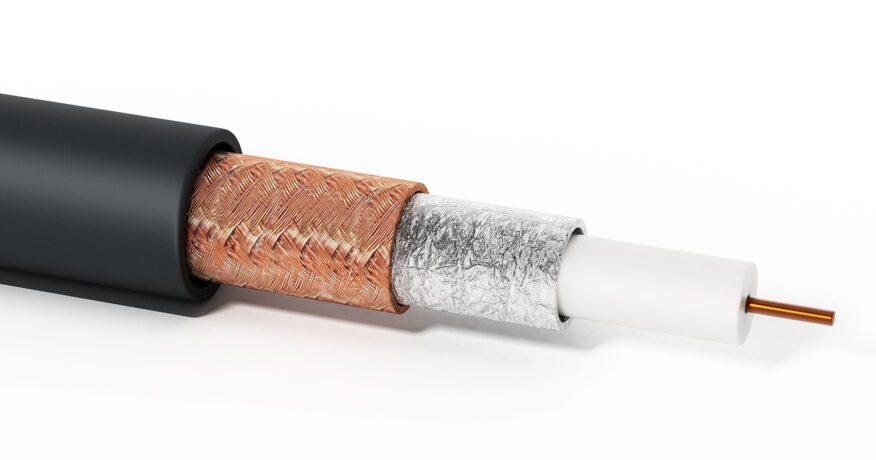Are you tired of dealing with a fuzzy or distorted TV signal? It might be time to take a closer look at your coaxial cable. As a critical transmission line for TV signals, the type of cable you use can have a significant impact on the quality of your picture.
For instance, a poorly-shielded cable may be susceptible to interference from other devices, resulting in ghosting or other visual anomalies. Fortunately, selecting a well-shielded coaxial cable can help protect against such interference.
Another important factor to consider is the length of your cable, as longer cables tend to experience more signal loss. By choosing the appropriate cable type, you can help ensure a clear and stable connection between your antenna and TV for optimal viewing enjoyment.
In this article we will look at the best types of coax cable for your TV antenna, and what makes them the top choices.
Understanding Coaxial Cable

Coaxial cables are electrical transmission lines designed to carry high-frequency radio signals from one point to another with minimal signal loss.
They are commonly used for various applications such as phone lines, cable TV, internet, and cell boosters. In this section, we will discuss the different types of coax cables and their key specifications for better understanding and selection.
Types of Coax Cables
| Coaxial Cable Type | RG6 | RG59 | RG11 |
|---|---|---|---|
| Signal Loss (dB/100ft) | 5.9 | 7.4 | 1.5 |
| Frequency Range (MHz) | 0-1000 | 0-750 | 0-3000 |
| Shielding | Double or Quad | Single | Double or Quad |
| Recommended Use | Best for HDTV antennas and cable modems | Best for analog TV and CCTV | Best for long cable runs and commercial installations |
There are several types of coaxial cables available, each designed for specific uses. Some of the commonly used cables for TV antennas are:
- RG-6: A heavier gauge compared to RG-59 and designed for high-bandwidth, high-frequency applications. RG-6 is the preferred choice for HDTV antenna installations.
- RG-11: A thicker cable that provides even lower signal loss compared to RG-6, making it suitable for longer cable runs.
- RG-59: An older type of cable, typically used in older cable installations, but not recommended for modern HDTV antenna setups due to its higher signal loss and poor shielding.
Key Specifications
When selecting a coaxial cable for your TV antenna, it is essential to consider the following key specifications:
- Impedance: The resistance offered by the cable to the flow of electrical signals. Most TV antenna applications use a 75-ohm impedance.
- Shielding: The protection provided by the cable to minimize signal interference from external factors. Quad-shielded cables, such as the Postta Digital Coaxial Cable, offer superior shielding to reduce signal disruption.
- Attenuation: The signal loss that occurs over the length of the cable. Choose a cable with lower attenuation, especially for longer runs, to ensure optimal signal quality.
- Connectors: F-type connectors are commonly used for TV antenna installations. Ensure compatibility with your devices, and select high-quality connectors to minimize signal loss.
Understanding the types of coaxial cables and their key specifications will help you make informed decisions when selecting the best coax cable for your TV antenna setup.
Best Coax Cables for TV Antennas
Selecting the right coaxial cable for your TV antenna is crucial for optimal signal quality and minimizing loss. In this section, we’ll explore the best types of coax cable for TV antennas: RG-6, RG-11, and quad-shielded coax cables.
RG-6
The RG-6 coaxial cable is a popular choice for TV antennas due to its low signal loss over longer distances. This cable has a smaller diameter and is more flexible, making it easy to install.
Some of the best RG-6 cables for HDTV include the Mediabridge Coaxial Cable and RELIAGINT RG6 coaxial cable.
RG-11
RG-11 coaxial cables are specifically designed for HDTV and provide better signal quality due to lower attenuation. However, it has a larger diameter and is less flexible, making it challenging to bend and install. RG-11’s increased air space allows for improved signal transfer, making it ideal for strong HD signals.
Quad-Shielded Coax Cables
Quad-shielded coax cables have four layers of shielding that provide better interference protection, ensuring the best signal quality for HDTV. The Southwire RG6 Quad Shield Communication Cable is a top choice for those looking for a quad-shielded cable. This enhanced shielding allows for optimal reception performance in areas with high signal interference.
To summarize, the best coaxial cable for your TV antenna depends on your specific needs, installation requirements, and desired signal strength. Consider the benefits and drawbacks of each type to make an informed decision.
Section 4: Factors to Consider When Choosing a Coax Cable
When selecting the best coax cable for your TV antenna, there are several important factors you need to consider. In this section, we will discuss cable length, signal strength, cable quality, and weather resistance.
Cable Length
Choosing the appropriate cable length is essential for maintaining signal quality. The longer the cable, the more signal loss can occur. Therefore, it’s best to use the shortest cable possible that meets your needs. However, ensure that the cable is long enough to reach your TV antenna without causing any strain or tension.
Signal Strength
Signal strength is a vital factor when choosing a coax cable for your TV antenna. A cable with low signal loss will maintain better signal quality, leading to improved image and sound quality. For instance, GE RG6 Coaxial Cable has been recommended for its 3 GHz digital signal transmission capability. Always check the specifications of the cable for its signal loss (measured in dB) before making a purchase decision.
Cable Quality
Cable quality plays a crucial role in overall performance. High-quality cables typically have better shielding and materials, ensuring less signal interference and increased durability. Look for cables with quad shielding and gold-plated connectors for optimal performance. Additionally, in-wall rated cables are ideal for installations where the cable needs to be run through walls.
Weather Resistance
When installing an outdoor TV antenna, it’s essential to consider the weather resistance of the coax cable. A cable with UV-resistant and waterproof properties will ensure longevity and continued performance even in harsh weather conditions. Make sure to check the cable’s specifications for weather resistance before purchasing.
Section 5: Installing and Connecting Coax Cables
In this section, we will discuss the proper techniques, quality connectors, and cable management for installing and connecting coax cables for TV antennas.
Proper Techniques
When installing coax cables, it is important to follow proper techniques to ensure optimal signal transmission. Some key steps include:
- Strip the cable’s outer layer carefully, and avoid nicking or cutting the inner conductor and insulation
- Ensure the cable is securely connected to both the antenna and the television
- Use a crimper or compression tool for a secure connection
By following these techniques, you can ensure a stable and clear signal for your TV antenna.
Quality Connectors
Choosing the right connectors is crucial for a high-quality connection. Compression connectors are highly recommended as they provide the most secure and reliable connection for your coax cable. Avoid using push-on, screw-on, and crimp-on connectors as they are less reliable and can result in signal loss.
Compression connectors also help maintain the cable’s shielding, which is important in minimizing interference from other devices and improving overall performance.
Cable Management
Proper cable management can help prolong the life of your coax cables and maintain their performance. Some tips to keep in mind are:
- Route cables away from power sources and other sources of interference
- Use cable ties or clips to keep cables organized and avoid tangling
- Avoid bending coax cables too tightly, as this can damage the cable and degrade signal quality
Maintaining good cable management can save time and prevent issues from arising in the future, ensuring a seamless TV antenna signal.
